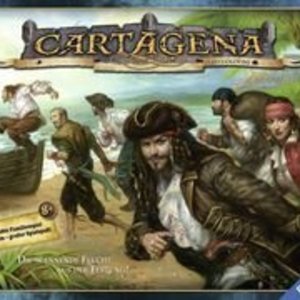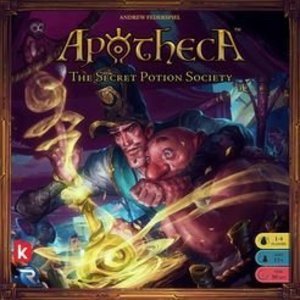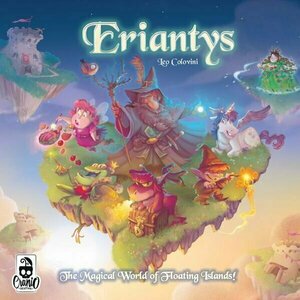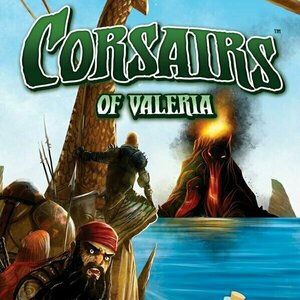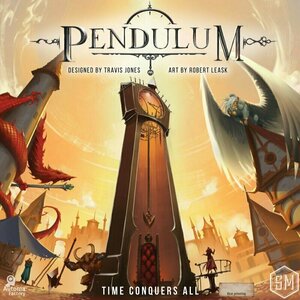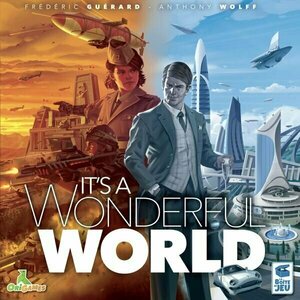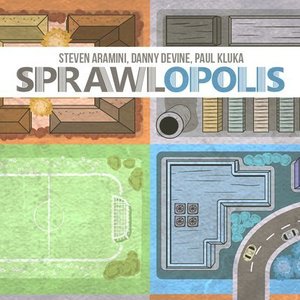Search
Search results

Walk the Plank!
Tabletop Game
In Walk the Plank!, players represent the worst pirates in a captain's crew. The captain has rounded...

Dingo's Dreams
Tabletop Game
Dingo and his friends have gotten lost on Walkabout! Visit their dreams to lead them home! ...

VENOM Assault
Tabletop Game
In the year 2050 the United Nations made a startling discovery that changed the course of the...
Purple Phoenix Games (2266 KP) rated Corsairs of Valeria in Tabletop Games
Apr 2, 2021
If you look at my current Top 10 List (at date of publication), you will see that my #1 game is Valeria Card Kingdoms. I just love the lore, mechanics, artwork, and gameplay so much that it easily rose to my #1 spot after just 1 play! So I am definitely a sucker for all things Valeria. Quests of Valeria, Villagers of Valeria – you name it, I’ve got it. So when the latest VCK expansion was on Kickstarter, with the option to add a new little Valeria-verse themed dice game, I knew I was all in. Does Corsairs of Valeria live up to the hype of its predecessors?
Corsairs of Valeria is a dice rolling game in which players are racing to sail the Valerian islands and collect 6 treasure chests before any of the other pirate captains do. The first person to do so will claim the position of Commodore, and its associated status and power! To setup the game, each player receives a Ship board and ship meeple in their chosen color, 2 silver, and is randomly given a Captain card for the game. Each Captain card gives players a different special power to be used throughout the game. Ship boards have 2 dials to track Treasures and Grog. Set up the Start Island, shuffle and select 3 island Tracks to be placed above the Start, and finally end the lineup with Skull Island. Place 2 silver on Skull Island, and the game is ready to begin!
Each turn has four phases: Roll, Re-roll, Actions, End turn. First, gather all 5 dice and roll them. In the Re-roll phase, players may pay 1 Grog to re-roll any or all of their dice. You may re-roll as many times as you wish per turn, as long as you have Grog to spend. Once you are satisfied with your die rolls, you perform the actions shown on each die. Cursed dice must be executed first – for any dice that have a Skull on them, you must pay 1 silver to Skull Island per skull face shown. After Skulls are resolved, the rest of the die faces may be executed in any order you wish, as long as you resolve all the same symbols at the same time. The Grog symbol allows you to gain 1 Grog, the Silver symbol allows you to gain 1 silver, and the Map symbols allows you to move your ship meeple 1 space on the island track. Certain islands on the track provide additional resources once they are passed, so collect those as applicable. A Cannon symbol allows you to attack – either an opponent or a Merchant ship. To attack an opponent, you must roll at least 3 cannon symbols, and the chosen opponent then must give you all of their silver. To attack a Merchant ship, you must be sharing a space on the track with a Merchant ship, and you collect the resources printed on the ship for the number of cannons you spend to attack. After you have executed all of your dice actions, pass the dice to the next player and your turn is over.
At any point during the game, when you acquire 5 silver, you immediately trade them in for 1 treasure. Treasure is tracked on your ship board. The first player to reach 6 treasures wins the game! If, during the game, a player reaches Skull Island before 6 treasures have been claimed, a few things happen. First, that player receives all of the silver on Skull Island. Next, all ships are moved back to the Start Island, the 3 island Tracks are flipped to their opposite sides, and 2 silver are once again placed on Skull Island. The game continues in turn order, just now with new Tracks in play. If any player reaches Skull Island for a second time during the game, then the game ends once that player finishes their turn. In that case, if 6 treasures still have not been claimed, the player with the most Treasure wins.
I’m just going to start this off by saying that I love Corsairs of Valeria. Just like the other members of the Valeria family, this one checks off all the boxes that I love: great artwork, solid mechanics, and enjoyable immersion in the universe of Valeria. Let’s talk about gameplay first. At its core, Corsairs of Valeria is a dice rolling game, which is a luck-based mechanic. However, this game does provide options to employ strategies through the Captain powers and re-roll phase that give the player a little bit more control over what they can do each turn. Maybe you’re bad at rolling dice, but having the option to pay 1 Grog to re-roll any/all dice can get you out of a bad jam. Or maybe you have a powerful Captain ability that can really dictate your strategy and offer a path to success. It’s not just about the dice rolls, but about what you do to use those rolls to your benefit. So overall that just makes the game feel more engaging and enjoyable to me because I as a player have the ability to strategize each turn, I am not just at the mercy of the dice.
Another thing that I love about Corsairs of Valeria is that it is so simple, quick, and light to play. The rules seem a little involved at first, but ultimately here’s how a turn plays out: roll dice, re-roll if desired, perform actions/collect resources, end turn. The symbology is straight-forward, the turn phases are logical and concise, and there really is no down-time between turns. It requires strategy but still feels light enough to be a good palate cleanser or introductory game for newer gamers. And an awesome thing with quick games is that it is so easy to play several games in a row. I play at least 3 games of Corsairs before I decide to move on to the next game in my queue.
The consistency and continuity between all of the Valeria games is a huge plus for me. I love the artwork and appreciate that Daily Magic Games keeps bring back the same artist to create a cohesive universe! All of the Valeria games stand alone from each other, but the style and artwork make them all feel like a united entity.
Maybe I am a bit biased because VCK is my #1 game right now, but I think that Corsairs of Valeria is great. It is easily in my Top 20 games, and could continue moving up the list with more plays. It’s fast and light, yet strategic and engaging enough that it keeps me excited and energized throughout. There’s not a down moment when playing this game because ultimately, it’s a race! Keep an eye on the opponents, decide which strategy is best with your given die roll, and get a move on to get those treasures and best your rival captains. Purple Phoenix Games gives Corsairs of Valeria a sea-worthy 10 / 12.
Corsairs of Valeria is a dice rolling game in which players are racing to sail the Valerian islands and collect 6 treasure chests before any of the other pirate captains do. The first person to do so will claim the position of Commodore, and its associated status and power! To setup the game, each player receives a Ship board and ship meeple in their chosen color, 2 silver, and is randomly given a Captain card for the game. Each Captain card gives players a different special power to be used throughout the game. Ship boards have 2 dials to track Treasures and Grog. Set up the Start Island, shuffle and select 3 island Tracks to be placed above the Start, and finally end the lineup with Skull Island. Place 2 silver on Skull Island, and the game is ready to begin!
Each turn has four phases: Roll, Re-roll, Actions, End turn. First, gather all 5 dice and roll them. In the Re-roll phase, players may pay 1 Grog to re-roll any or all of their dice. You may re-roll as many times as you wish per turn, as long as you have Grog to spend. Once you are satisfied with your die rolls, you perform the actions shown on each die. Cursed dice must be executed first – for any dice that have a Skull on them, you must pay 1 silver to Skull Island per skull face shown. After Skulls are resolved, the rest of the die faces may be executed in any order you wish, as long as you resolve all the same symbols at the same time. The Grog symbol allows you to gain 1 Grog, the Silver symbol allows you to gain 1 silver, and the Map symbols allows you to move your ship meeple 1 space on the island track. Certain islands on the track provide additional resources once they are passed, so collect those as applicable. A Cannon symbol allows you to attack – either an opponent or a Merchant ship. To attack an opponent, you must roll at least 3 cannon symbols, and the chosen opponent then must give you all of their silver. To attack a Merchant ship, you must be sharing a space on the track with a Merchant ship, and you collect the resources printed on the ship for the number of cannons you spend to attack. After you have executed all of your dice actions, pass the dice to the next player and your turn is over.
At any point during the game, when you acquire 5 silver, you immediately trade them in for 1 treasure. Treasure is tracked on your ship board. The first player to reach 6 treasures wins the game! If, during the game, a player reaches Skull Island before 6 treasures have been claimed, a few things happen. First, that player receives all of the silver on Skull Island. Next, all ships are moved back to the Start Island, the 3 island Tracks are flipped to their opposite sides, and 2 silver are once again placed on Skull Island. The game continues in turn order, just now with new Tracks in play. If any player reaches Skull Island for a second time during the game, then the game ends once that player finishes their turn. In that case, if 6 treasures still have not been claimed, the player with the most Treasure wins.
I’m just going to start this off by saying that I love Corsairs of Valeria. Just like the other members of the Valeria family, this one checks off all the boxes that I love: great artwork, solid mechanics, and enjoyable immersion in the universe of Valeria. Let’s talk about gameplay first. At its core, Corsairs of Valeria is a dice rolling game, which is a luck-based mechanic. However, this game does provide options to employ strategies through the Captain powers and re-roll phase that give the player a little bit more control over what they can do each turn. Maybe you’re bad at rolling dice, but having the option to pay 1 Grog to re-roll any/all dice can get you out of a bad jam. Or maybe you have a powerful Captain ability that can really dictate your strategy and offer a path to success. It’s not just about the dice rolls, but about what you do to use those rolls to your benefit. So overall that just makes the game feel more engaging and enjoyable to me because I as a player have the ability to strategize each turn, I am not just at the mercy of the dice.
Another thing that I love about Corsairs of Valeria is that it is so simple, quick, and light to play. The rules seem a little involved at first, but ultimately here’s how a turn plays out: roll dice, re-roll if desired, perform actions/collect resources, end turn. The symbology is straight-forward, the turn phases are logical and concise, and there really is no down-time between turns. It requires strategy but still feels light enough to be a good palate cleanser or introductory game for newer gamers. And an awesome thing with quick games is that it is so easy to play several games in a row. I play at least 3 games of Corsairs before I decide to move on to the next game in my queue.
The consistency and continuity between all of the Valeria games is a huge plus for me. I love the artwork and appreciate that Daily Magic Games keeps bring back the same artist to create a cohesive universe! All of the Valeria games stand alone from each other, but the style and artwork make them all feel like a united entity.
Maybe I am a bit biased because VCK is my #1 game right now, but I think that Corsairs of Valeria is great. It is easily in my Top 20 games, and could continue moving up the list with more plays. It’s fast and light, yet strategic and engaging enough that it keeps me excited and energized throughout. There’s not a down moment when playing this game because ultimately, it’s a race! Keep an eye on the opponents, decide which strategy is best with your given die roll, and get a move on to get those treasures and best your rival captains. Purple Phoenix Games gives Corsairs of Valeria a sea-worthy 10 / 12.
Purple Phoenix Games (2266 KP) rated Pendulum in Tabletop Games
Sep 8, 2020
This review, like the many others in the Solo Chronicles series before it, will be focusing on the solo player’s experience. For the highly-anticipated Pendulum, an Automa Factory set of solo rules is included. Automa Factory creates rules for solo play for games and have created many for Stonemaier titles in the past. This is my first time using an Automa ruleset, and I wanted to know: how do Automa games play vs a group playthrough? Find out below.
Pendulum is a real-time worker placement game utilizing sand timers to control players’ actions. While sand timers have been used in games plenty of times before, they are special components in Pendulum that will have players cursing their existence throughout the game. In a solo game the human player will be attempting to win against two Automas, essentially creating a three player game. Now, while I normally reconstruct the rules in my reviews to give a brief overview, Pendulum has too many intricacies to truly detail, so my rules overview will be quite abbreviated.
DISCLAIMER: We were provided a copy of this game for the purposes of this review. This is a retail copy of the game, so what you see in these photos is exactly what would be received in your box. I do not intend to cover every single rule included in the rulebook, but will describe the overall game flow and major rule set so that our readers may get a sense of how the game plays. For more in depth rules, you may purchase a copy online or from your FLGS. -T
Setup took me about 30 minutes the first game because I did not play it multiplayer first, but was setting up for my first Automa play. Setup is not difficult, but there are many small parts and different boards for which you must account. Subsequent games took significantly less time to setup so I was up and running immediately.
A game of Pendulum sees players vying for the crown by jockeying for mastery in Power, Prestige, Popularity, and completing a Legendary Achievement. These are all tracked on each player mat and the Automas’ mat. The game is a typical worker placement with all spaces giving some benefit, but also may be blocked by other players. By utilizing aggressive strategies and timing each worker action players will be gaining resources and votes and converting them into VPs on the individual tracks, the most important of which is the Legendary Achievement. No player may win the game without having completed a Legendary Achievement.
As the game progresses in real time, the sand timers will be flipped into areas blocking access to players, but allowing player meeples already stationed in these areas to enact their special abilities. Three timers of different time-lengths are used in Pendulum: 45 seconds, 2 minutes, and 3 minutes. The action spaces corresponding to the 45 second timer are less effective than the 3 minute timer areas, but are indeed necessary to generate more resources.
After the 3 minute purple timer has been flipped three total times, the game halts and a special Council Phase is enacted. This phase allows players to receive Council Reward cards, assess and compare placement for the next round, and set up for the next round. After the fourth Council Phase, the game ends and players will check for victory conditions.
Components. Have you seen a Stonemaier Games title recently? The components are stellar. Everything from the plastic (resin?) cubes and vote tiles and meeples, to the good-looking sand timers, to the linen finish on the cards AND the rulebooks is just amazing. Several reviewers have issues with the art in Pendulum, and say that it is drab and “uninspiring.” Well, I think it’s great, and I also think it is a bit muted to get out of the way of play. I certainly would not appreciate this game more if it had more exciting art. More exciting art means more attention spent on appreciating the art and not playing the game. Normally this is a boon for me, but Pendulum is a REAL-TIME game. I don’t have time to be gawking at game art! Components: excellent!
I really enjoyed my plays of Pendulum using the Automa system. I can’t necessarily say it felt like playing against two other players, but I don’t think it’s meant to do that. The Automa players sufficiently block spaces, and gain VP each round to compete with the human player. Also, I have never played a game using Automas before, so I had zero expectations getting into Pendulum. I do think I would enjoy this game lots more playing against other humans, but the current virus situation has nixed that for me. The Automa system is good, and I am so happy that it exists for Pendulum. I just want to play it with other gamers.
Purple Phoenix Games never award games with scores for previews and Solo Chronicles. However, I would certainly rate Pendulum high. I don’t believe it will ever crack into my Top 10 Games of All Time, but I also can see myself pulling it out when I want to exercise my brain and I don’t have access to any other gamers. I want you to understand that I do like this one quite a bit, and would certainly recommend it. I truly enjoy having to keep on my toes (literally) controlling my components as well as keeping track of the Automa movements, and assuring the timers are being flipped appropriately.
If your collection is missing a game that utilizes sand timers for more than just buzzing others on their turn, certainly give Pendulum a look. The design is fantastic, includes the Automa Factory solo rules (and extra components), and is satisfying to play. Heck, I didn’t even sit down when I played this because I needed to be so active around the board. If it weren’t so late as I am writing this, I would break it out and give it another go right now. Alas, I am old and need to sleep. Check out Pendulum.
Pendulum is a real-time worker placement game utilizing sand timers to control players’ actions. While sand timers have been used in games plenty of times before, they are special components in Pendulum that will have players cursing their existence throughout the game. In a solo game the human player will be attempting to win against two Automas, essentially creating a three player game. Now, while I normally reconstruct the rules in my reviews to give a brief overview, Pendulum has too many intricacies to truly detail, so my rules overview will be quite abbreviated.
DISCLAIMER: We were provided a copy of this game for the purposes of this review. This is a retail copy of the game, so what you see in these photos is exactly what would be received in your box. I do not intend to cover every single rule included in the rulebook, but will describe the overall game flow and major rule set so that our readers may get a sense of how the game plays. For more in depth rules, you may purchase a copy online or from your FLGS. -T
Setup took me about 30 minutes the first game because I did not play it multiplayer first, but was setting up for my first Automa play. Setup is not difficult, but there are many small parts and different boards for which you must account. Subsequent games took significantly less time to setup so I was up and running immediately.
A game of Pendulum sees players vying for the crown by jockeying for mastery in Power, Prestige, Popularity, and completing a Legendary Achievement. These are all tracked on each player mat and the Automas’ mat. The game is a typical worker placement with all spaces giving some benefit, but also may be blocked by other players. By utilizing aggressive strategies and timing each worker action players will be gaining resources and votes and converting them into VPs on the individual tracks, the most important of which is the Legendary Achievement. No player may win the game without having completed a Legendary Achievement.
As the game progresses in real time, the sand timers will be flipped into areas blocking access to players, but allowing player meeples already stationed in these areas to enact their special abilities. Three timers of different time-lengths are used in Pendulum: 45 seconds, 2 minutes, and 3 minutes. The action spaces corresponding to the 45 second timer are less effective than the 3 minute timer areas, but are indeed necessary to generate more resources.
After the 3 minute purple timer has been flipped three total times, the game halts and a special Council Phase is enacted. This phase allows players to receive Council Reward cards, assess and compare placement for the next round, and set up for the next round. After the fourth Council Phase, the game ends and players will check for victory conditions.
Components. Have you seen a Stonemaier Games title recently? The components are stellar. Everything from the plastic (resin?) cubes and vote tiles and meeples, to the good-looking sand timers, to the linen finish on the cards AND the rulebooks is just amazing. Several reviewers have issues with the art in Pendulum, and say that it is drab and “uninspiring.” Well, I think it’s great, and I also think it is a bit muted to get out of the way of play. I certainly would not appreciate this game more if it had more exciting art. More exciting art means more attention spent on appreciating the art and not playing the game. Normally this is a boon for me, but Pendulum is a REAL-TIME game. I don’t have time to be gawking at game art! Components: excellent!
I really enjoyed my plays of Pendulum using the Automa system. I can’t necessarily say it felt like playing against two other players, but I don’t think it’s meant to do that. The Automa players sufficiently block spaces, and gain VP each round to compete with the human player. Also, I have never played a game using Automas before, so I had zero expectations getting into Pendulum. I do think I would enjoy this game lots more playing against other humans, but the current virus situation has nixed that for me. The Automa system is good, and I am so happy that it exists for Pendulum. I just want to play it with other gamers.
Purple Phoenix Games never award games with scores for previews and Solo Chronicles. However, I would certainly rate Pendulum high. I don’t believe it will ever crack into my Top 10 Games of All Time, but I also can see myself pulling it out when I want to exercise my brain and I don’t have access to any other gamers. I want you to understand that I do like this one quite a bit, and would certainly recommend it. I truly enjoy having to keep on my toes (literally) controlling my components as well as keeping track of the Automa movements, and assuring the timers are being flipped appropriately.
If your collection is missing a game that utilizes sand timers for more than just buzzing others on their turn, certainly give Pendulum a look. The design is fantastic, includes the Automa Factory solo rules (and extra components), and is satisfying to play. Heck, I didn’t even sit down when I played this because I needed to be so active around the board. If it weren’t so late as I am writing this, I would break it out and give it another go right now. Alas, I am old and need to sleep. Check out Pendulum.
Purple Phoenix Games (2266 KP) rated It's a Wonderful World in Tabletop Games
Oct 30, 2021
When choosing board games to either play or purchase, how much importance should one put on box cover art? It is important to ME, but I lump that all in with the components and art/art style of the whole package. Why do I bring this up in the intro today? Well, I have to admit that I had really not had any interest in checking out It’s a Wonderful World until now because I judged the game by its cover, and the cover art told my brain that this would be some type of wargame. I am not entirely sure how I connected the two, but I did, and it turned me off right away. But! I was able to get this played at a local board game lounge, and boy was I wrong.
It’s a Wonderful World is a card drafting, economic, civilization building game with variable player powers (with a dash of campaign mode sprinkled on top). In it, players are attempting to build their civilization faster and better than their competitors. However, for this review, I will be playing the vanilla non-scenario solo mode.
DISCLAIMER: I was able to play this and several other games at The Table in Cookeville, TN. If you are ever in the neighborhood, check them out, and tell Nathaniel that I say hello.
To setup, put together the main board and place the round marker on Round 1. Lay out all the resources on their specific places upon the board and shuffle the deck of cards. Deal out eight stacks of five cards each and place them as mini-decks somewhere on the table. Choose a starting civilization (or just randomly choose one). The solo game is ready to play!
Typically, It’s a Wonderful World is a card drafting game, a la 7 Wonders, where players choose one card from the deck passed to them and pass it along to the next player until all cards have been drafted. In the solo mode, however, the player chooses one of the face-down mini-decks as their starting hand. Upon viewing the cards, the player may choose to place any or all of them in their Construction Area, or discard the cards for their Recycle Bonus (typically a type of resource), and/or discard two card from the mini-deck to draw five cards from the top of the main deck. From these drawn cards, the player may choose one to keep and discard all others. The kept card may be placed into the Construction Area or discarded for its Recycle Bonus resource.
Cards placed in the Construction Area require resources to be earned and placed on them in order to complete its build process. Each round the player will receive resources based on which cards have been built and placed above their starting civ card. Some cards, once completely built, will also offer more VP at game end, or supply a VP modifier.
After the first mini-deck has been played completely, the player will choose a second mini-deck and run through the same process. After this second mini-deck has been completed the round ends and play moves to the next round. Play continues in this fashion until all four rounds have been played (so all eight mini-decks). At game end the player counts up all their VP and compares it to the table in the rulebook to arrive at their final tier. My first game resulted in the rulebook calling me a Rooky. So be prepared to be humiliated by a rulebook.
Components. Aside from being bamboozled by the aggressive artwork on the cover, this is not a wargame. In fact, I very much like the artwork and the styling of this game. The cards are all laid out very well, and the iconography makes sense. The resource cubes are translucent colored (except the grayish white is opaque) and are fine quality. Overall the components are great and the art style has grown on me quite a bit.
I can see why so many people compare this to 7 Wonders. Essentially, the multiplayer game is quite similar. Card drafts (of 7 cards, no less) lead to needing resources in order to build, lead to being able to produce more resources to fuel other cards, and bonus points are awarded for having a nice card profile. Now, this being a solo review, I have to say that I much prefer It’s a Wonderful World to its forefather 7 Wonders because it comes packaged with a solo mode already in the box. This isn’t the only reason I prefer it, though. I find it easier to pick up and easier to teach to beginning gamers. Also, there is no card chaining, which seems to be a difficult concept for newer gamers to grasp initially. It’s a Wonderful World has nothing like this, and cards just work. 7 Wonders has been such a hit with my family, and I know they will greatly appreciate a more streamlined game experience with this one.
So here’s my recommendation with this one. If you are a fan of 7 Wonders but find it to be difficult to get others into it, check out It’s a Wonderful World. I feel that it is superior in many ways, and the solo mode is just icing. The solo mode gives me a great play experience, even though I typically am not a fan of games challenging you to beat your own high score. I will live with it here because the game is just so enjoyable. While 7 Wonders was my favorite game of all time for quite a while, it has since dropped out of my Top 10, and I think will be replaced entirely by It’s a Wonderful World. If your tastes are similar to mine, then do yourself a big favor and grab a copy of this one right away. It has several expansions out there, and I believe you will fall in love with drafting again. Now, where did I put my Wind Turbines…
It’s a Wonderful World is a card drafting, economic, civilization building game with variable player powers (with a dash of campaign mode sprinkled on top). In it, players are attempting to build their civilization faster and better than their competitors. However, for this review, I will be playing the vanilla non-scenario solo mode.
DISCLAIMER: I was able to play this and several other games at The Table in Cookeville, TN. If you are ever in the neighborhood, check them out, and tell Nathaniel that I say hello.
To setup, put together the main board and place the round marker on Round 1. Lay out all the resources on their specific places upon the board and shuffle the deck of cards. Deal out eight stacks of five cards each and place them as mini-decks somewhere on the table. Choose a starting civilization (or just randomly choose one). The solo game is ready to play!
Typically, It’s a Wonderful World is a card drafting game, a la 7 Wonders, where players choose one card from the deck passed to them and pass it along to the next player until all cards have been drafted. In the solo mode, however, the player chooses one of the face-down mini-decks as their starting hand. Upon viewing the cards, the player may choose to place any or all of them in their Construction Area, or discard the cards for their Recycle Bonus (typically a type of resource), and/or discard two card from the mini-deck to draw five cards from the top of the main deck. From these drawn cards, the player may choose one to keep and discard all others. The kept card may be placed into the Construction Area or discarded for its Recycle Bonus resource.
Cards placed in the Construction Area require resources to be earned and placed on them in order to complete its build process. Each round the player will receive resources based on which cards have been built and placed above their starting civ card. Some cards, once completely built, will also offer more VP at game end, or supply a VP modifier.
After the first mini-deck has been played completely, the player will choose a second mini-deck and run through the same process. After this second mini-deck has been completed the round ends and play moves to the next round. Play continues in this fashion until all four rounds have been played (so all eight mini-decks). At game end the player counts up all their VP and compares it to the table in the rulebook to arrive at their final tier. My first game resulted in the rulebook calling me a Rooky. So be prepared to be humiliated by a rulebook.
Components. Aside from being bamboozled by the aggressive artwork on the cover, this is not a wargame. In fact, I very much like the artwork and the styling of this game. The cards are all laid out very well, and the iconography makes sense. The resource cubes are translucent colored (except the grayish white is opaque) and are fine quality. Overall the components are great and the art style has grown on me quite a bit.
I can see why so many people compare this to 7 Wonders. Essentially, the multiplayer game is quite similar. Card drafts (of 7 cards, no less) lead to needing resources in order to build, lead to being able to produce more resources to fuel other cards, and bonus points are awarded for having a nice card profile. Now, this being a solo review, I have to say that I much prefer It’s a Wonderful World to its forefather 7 Wonders because it comes packaged with a solo mode already in the box. This isn’t the only reason I prefer it, though. I find it easier to pick up and easier to teach to beginning gamers. Also, there is no card chaining, which seems to be a difficult concept for newer gamers to grasp initially. It’s a Wonderful World has nothing like this, and cards just work. 7 Wonders has been such a hit with my family, and I know they will greatly appreciate a more streamlined game experience with this one.
So here’s my recommendation with this one. If you are a fan of 7 Wonders but find it to be difficult to get others into it, check out It’s a Wonderful World. I feel that it is superior in many ways, and the solo mode is just icing. The solo mode gives me a great play experience, even though I typically am not a fan of games challenging you to beat your own high score. I will live with it here because the game is just so enjoyable. While 7 Wonders was my favorite game of all time for quite a while, it has since dropped out of my Top 10, and I think will be replaced entirely by It’s a Wonderful World. If your tastes are similar to mine, then do yourself a big favor and grab a copy of this one right away. It has several expansions out there, and I believe you will fall in love with drafting again. Now, where did I put my Wind Turbines…
Purple Phoenix Games (2266 KP) rated Sprawlopolis in Tabletop Games
Jun 12, 2019
One of the best parts of the board gaming experience is finding a fun group of people with whom to play! Sometimes, though, coordinating a game night is easier said than done. We all must occasionally forego the group experience and face the world as the Lonely Only. But fear not! The world of solo-play is a vast and exciting realm! What follows is a chronicle of my journey into the solo-playing world – notes on gameplay, mechanics, rules, difficulty, and overall experience with solo variations of commonly multiplayer games! I hope this will provide some insight as you continue to grow your collection, or explore your already owned games!
If you had the chance to design a city, how would you do it? Would you have a park on every block for some nice greenery, or do you think a large commercial district will bring in more people? What about housing – would people live right in the heart of the city, or would they live more on the outskirts? The day has finally come where those decisions are up to you! Well, mostly. You’ve been hired to help design the ultimate city! The city officials have given you some specific requirements, but beyond that, the plans are up to you! Can you meet their needs while also maximizing your space? It’s time to put your skills to the test and build the best city ever!
Sprawlopolis is a cooperative card placement game of only 18 cards. Given 3 random scoring conditions, you must draw and play cards into the city to fulfill those requirements. Meet or exceed their score, and you win the game! Fail to do so, and you have not succeeded in building the city up to specifications. Be careful how you decide to place your cards, however, because depending on the scoring conditions in play, certain placements could result in negative points at the end of the game. Working together, you and your team must decide which cards to play at what time to ensure that the requirements are all met. Solo play is identical to cooperative play, except that you just always have a hand of 3 cards from which to play. The score to beat each game is dependent on the scoring conditions, so this game isn’t just another beat-your-own-high-score game – you actually have a specific number in mind.
For a game with only 18 cards, there is a lot of variability in Sprawlopolis. I have yet to play 2 identical games. The layout of each card is unique, as are all of the scoring conditions, so the possibilities are endless… almost! I also enjoy playing this game solo because it requires a decent amount of strategy. Three things factor into your final score (the scoring conditions, block groupings, and roads) and it is impossible to succeed by focusing on only one of them. Your strategy is always changing based on the cards in your hand, and you really have to think about how to best utilize each card for maximum end-game points. Depending on when and where you play a card, it could change the entire city so you have to be thinking about the big picture, literally! And a neat thing about Sprawlopolis is that you can overlap cards. So maybe a card you played earlier is not really ideal anymore, given your current hand, so you can just cover up either a portion of it or the entire card!
The hardest thing about Sprawlopolis for me is that certain combinations of scoring conditions can be difficult to complete. One may give you points for a certain type of city block, but then another may take away as many, or more, points for that same type of city block. Or one gives you points for certain roads, but all roads result in negative points during end-game scoring. Since the scoring conditions are chosen randomly, there’s not really a way to negate this unless you just re-draw those cards. You usually can’t just look at a scoring condition combination and know if it will be difficult or not either – you just have to try it. I’m not saying they’re impossible necessarily, just harder to successfully complete.
Overall, I think Sprawlopolis is a neat game. It’s fast and easy to learn, yet strategic enough to keep you coming back for more games. I like to use it as a nice light filler game between some bigger games, or I just like to play it if I’ve got a quick 15 minutes to spare! Sprawlopolis is a fun game to play with a group, and it’s also a fun game to play solo. In my arsenal of solo games, it’s definitely one on standby.
https://purplephoenixgames.wordpress.com/2019/02/11/solo-chronicles-sprawlopolis/
If you had the chance to design a city, how would you do it? Would you have a park on every block for some nice greenery, or do you think a large commercial district will bring in more people? What about housing – would people live right in the heart of the city, or would they live more on the outskirts? The day has finally come where those decisions are up to you! Well, mostly. You’ve been hired to help design the ultimate city! The city officials have given you some specific requirements, but beyond that, the plans are up to you! Can you meet their needs while also maximizing your space? It’s time to put your skills to the test and build the best city ever!
Sprawlopolis is a cooperative card placement game of only 18 cards. Given 3 random scoring conditions, you must draw and play cards into the city to fulfill those requirements. Meet or exceed their score, and you win the game! Fail to do so, and you have not succeeded in building the city up to specifications. Be careful how you decide to place your cards, however, because depending on the scoring conditions in play, certain placements could result in negative points at the end of the game. Working together, you and your team must decide which cards to play at what time to ensure that the requirements are all met. Solo play is identical to cooperative play, except that you just always have a hand of 3 cards from which to play. The score to beat each game is dependent on the scoring conditions, so this game isn’t just another beat-your-own-high-score game – you actually have a specific number in mind.
For a game with only 18 cards, there is a lot of variability in Sprawlopolis. I have yet to play 2 identical games. The layout of each card is unique, as are all of the scoring conditions, so the possibilities are endless… almost! I also enjoy playing this game solo because it requires a decent amount of strategy. Three things factor into your final score (the scoring conditions, block groupings, and roads) and it is impossible to succeed by focusing on only one of them. Your strategy is always changing based on the cards in your hand, and you really have to think about how to best utilize each card for maximum end-game points. Depending on when and where you play a card, it could change the entire city so you have to be thinking about the big picture, literally! And a neat thing about Sprawlopolis is that you can overlap cards. So maybe a card you played earlier is not really ideal anymore, given your current hand, so you can just cover up either a portion of it or the entire card!
The hardest thing about Sprawlopolis for me is that certain combinations of scoring conditions can be difficult to complete. One may give you points for a certain type of city block, but then another may take away as many, or more, points for that same type of city block. Or one gives you points for certain roads, but all roads result in negative points during end-game scoring. Since the scoring conditions are chosen randomly, there’s not really a way to negate this unless you just re-draw those cards. You usually can’t just look at a scoring condition combination and know if it will be difficult or not either – you just have to try it. I’m not saying they’re impossible necessarily, just harder to successfully complete.
Overall, I think Sprawlopolis is a neat game. It’s fast and easy to learn, yet strategic enough to keep you coming back for more games. I like to use it as a nice light filler game between some bigger games, or I just like to play it if I’ve got a quick 15 minutes to spare! Sprawlopolis is a fun game to play with a group, and it’s also a fun game to play solo. In my arsenal of solo games, it’s definitely one on standby.
https://purplephoenixgames.wordpress.com/2019/02/11/solo-chronicles-sprawlopolis/
